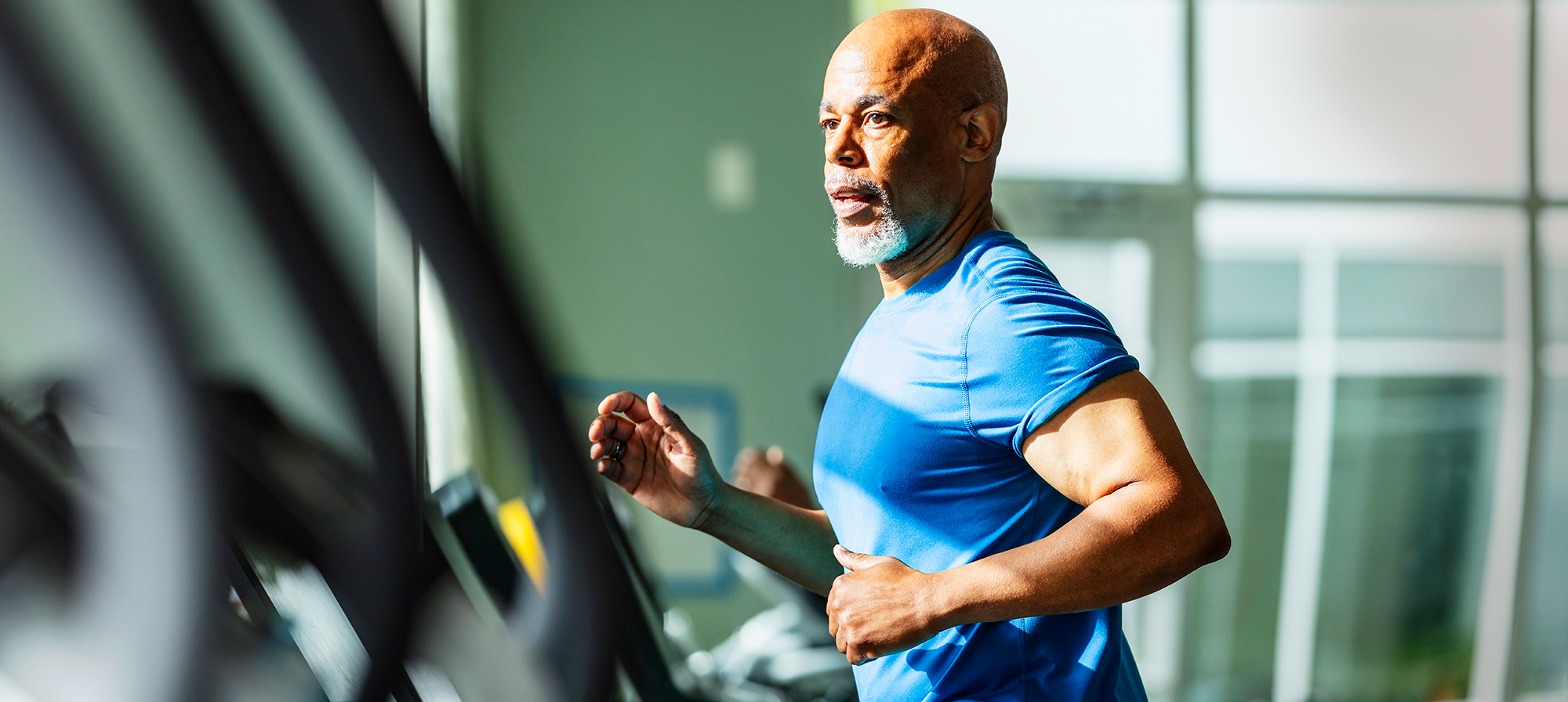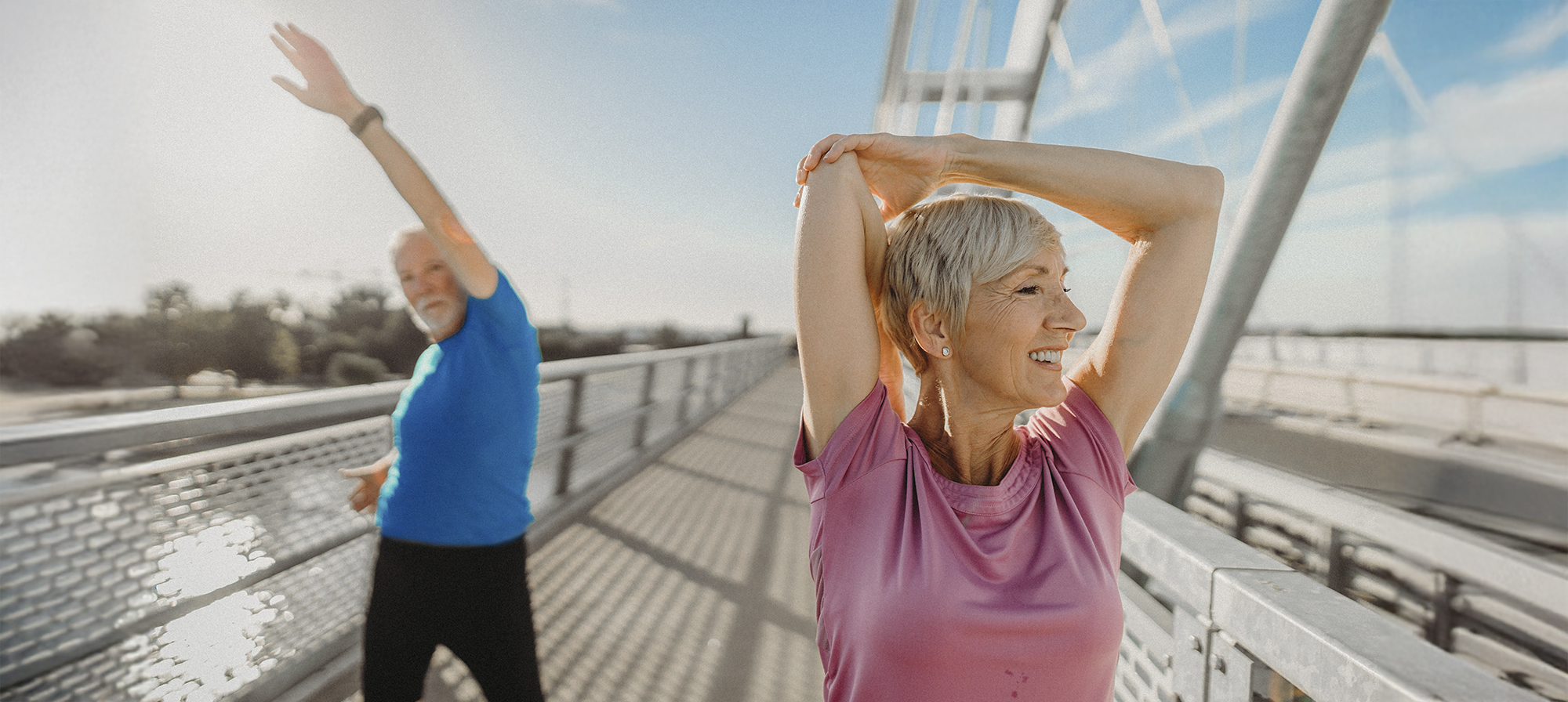You may think joint pain and stiffness are reasons to skip your workouts and rest. But exercising with arthritis, not resting, is what helps ease your symptoms.
If you have arthritis, hitting the gym is likely the last thing on your mind. You may think staying off your feet and resting for most of the day is best. But too much rest and a lack of movement and exercise weaken the muscles that support your joints. This can actually cause more pain and stiffness, not less. On the other hand, exercising with arthritis can help ease your joint pain and stiffness. The key is knowing what kinds of exercises are best for you.
So, while it may sound counterintuitive, movement can ease arthritis pain by:
- Boosting the production of synovial fluid within the joint capsules, which lubricates them
- Increasing the flow of oxygen and nutrients to the joints and surrounding tissue
- Strengthening the muscles around the joints, which helps support them
- Boosting your energy
- Lifting your mood
- Promoting quality sleep
Is it osteoarthritis (OA) or rheumatoid arthritis (RA)?
The kinds of exercise you’ll want to do can differ, based on whether you have osteoarthritis (OA) or rheumatoid arthritis (RA).
The most common form of arthritis is OA. It’s caused by wear and tear of the cartilage that covers the bones in your joints. This can cause pain, which affects your motivation and ability to exercise. That’s why it’s vital that you check with your doctor or physical therapist (PT) about which exercises are best for you.
With RA, it’s not wear and tear, but rather the immune system that attacks the joints, beginning with the cartilage that lines them. You may have flare ups of pain and disability. RA also can also cause other symptoms that impact the entire body. It’s very important that you’re in a doctor’s care for this disease.
If you do have RA, you’ll want to make sure you follow the plan of care set up by your doctor and/or PT.
If you have joint pain and you aren’t certain whether it’s OA or RA, talk with your doctor. The suggestions in this article are geared for those with OA, but some may also be helpful for those with RA, if your doctor or PT approves.

Exercising with arthritis: Tips for getting started
The discomfort of arthritis may have sidelined you from your previously active lifestyle. If so, and you are just getting back to exercising again, check with your health care team first. The type of exercises that are best for you will depend on your type and degree of arthritis, and which joints are affected.
When exercising with arthritis, it's key that you start slowly. Be kind to your joints. Go easy at first. Then gradually ramp up the intensity and duration of your workouts. This will prevent you from overworking muscles and worsening your joint pain.
Be sure to keep these tips in mind:
- Favor low-impact activities. Cycling may be a fun, low-impact way to get moving. Also, water workouts are known to cause less stress on your joints. Or you may want to head to the gym for a yoga class or a session on the elliptical machine. Walking offers a low-impact way to move, as well. Many people who walk, however, prefer a more giving surface than concrete sidewalks.
- Use heat or ice to manage pain. Choose which one works best to ease your pain. If you use heat, keep the temperature comfortably warm but not too hot. Limit your heat session to 20 minutes. Also, never apply heat to a swollen joint or if you’re having a flare up of pain. Heat can increase inflammation and swelling, and in turn worsen joint pain.
For ice, apply for 10-15 minutes and always keep a thin, wet towel between the pack and your skin. - Move gently before workouts to warm up your muscles and joints. You may want to do range-of-motion movements for 5 to 10 minutes before you move on to aerobic or strength training. Walking is also a great way to warm up before your workout.
- Go slowly and stop if you feel pain. Take a break if needed. If the pain is sharp, contact your doctor. Also, be sure to slow down or stop if you notice new or increased redness or swelling in your joints.
As you slowly become more active, listen to your body. Talk with your doctor or PT about your concerns, such as increased joint pain or swelling. If all is going well, continue a gradual build-up to longer, slightly more intense workouts.

Best exercises for arthritis
First, remember that any movement can help. This includes daily activities. Yardwork, such as raking leaves and mowing the lawn, can limber up your joints. Walking the dog gets you outside and moving. Even chores like housework or washing your car can get your body moving in a range of ways.
Talk to your doctor about working with a physical therapist (PT). A PT can set you up with exercises that are tailored to your needs and best suited for you.
Here’s a closer look at common exercises and how they can help ease symptoms of osteoarthritis.
- Range-of-motion (ROM) movements. These can help with flexibility and bring surprising relief. They lessen stiffness in your joints, including those affected by osteoarthritis. Actively moving your joint through its full range of motion will keep you mobile.
An example would be pulling your knee as far as you can up to your chest to flex your hip joint. Or you could move your arms in big circles, backwards and then forwards, to get full range of motion in your shoulder joints. - Strengthening exercises. Stronger muscles help support and protect your joints. Here are a few kinds to try:
- Body weight training. This calls for little or no equipment. Examples are lunges, push-ups, and squats.
- Resistance bands and tubing. You can do this training anywhere using elastic bands or tubing for resistance. Work your upper and lower body with bicep curls, rows, and squats.
- Free weights. Using dumbbells is an easy way to strength train. You can start with light weights and work up to heavier ones. Try biceps curls, squats, lunges, triceps extensions, and chest press.
- Weight machines. Used in the gym or at home, weight machines are another way to strength train. Check with your doctor or PT before trying a new type of machine. Ensure you are using the machines correctly. Watch a video or schedule a session with a trainer at your gym. After that you can use weight machines to do exercises such as knee extensions, hamstring curls, leg presses, seated rowing, and lat pulldowns.
Perform weight training sessions at least 2 days a week. If possible, weight training should work all the major muscle groups.
- Aerobic (cardiovascular) training. Aerobic exercise raises your heart rate and helps with overall fitness. This type of exercise boosts heart, lung, and brain health. It also increases energy and helps control weight. This is key because staying in a normal weight range may also help ease joint pain.
With osteoarthritis, you’ll want to stick with low-impact aerobic workouts, which are easier on the joints. Talk with your doctor or PT about how hard, how long, and how often you should do aerobic training. Guidelines for adults suggest 150 minutes per week of moderate-intensity cardiovascular exercise.
The best exercises for osteoarthritis vary from person to person. Be mindful of any increase in pain. Work with your doctor or PT to learn which exercises are best for you.

A word about safety and proper gear
It’s important to have the right clothes and gear for the activities you choose. Wear supportive, comfortable shoes. If you feel you need one, consider using an assistive device, such as a cane. (Check with your doctor or PT if you are unsure about what device is best for you.)
If you are walking outside, dress for the weather and stay away from slippery or uneven surfaces that may cause falls.

When exercising with osteoarthritis, don’t overdo it
Whatever form of movement you choose, pay attention to your level of joint pain. If you haven’t been active in a while, you may have stiffness and discomfort after exercise. A general rule of thumb is that discomfort shouldn’t feel worse more than a day after exercising.
If the discomfort lingers too long, you may need to cut back on your intensity, or the type or duration of your activity. Check with your doctor if your pain worsens and doesn’t improve.
It's also helpful to choose workouts you enjoy. If you like the water, try a water exercise class. You will stand in water about shoulder height and the buoyancy of the water eases the stress on your joints. These sessions can be especially helpful for those with knee and hip osteoarthritis. Or, if water workouts aren’t your thing, try biking or walking. They also work well for those with arthritis.
To find classes and places to work out, check local gyms and community centers. Also, the Arthritis Foundation offers exercise programs around the United States for people with arthritis. Contact your local branch for more information.
Bottom line, keep moving! Shift your mindset and remind yourself that exercising with arthritis can be fun, ease joint pain, and keep you moving more easily every day.

Not a Silver&Fit® member? Learn more about everything the program has to offer, including more helpful healthy living tips like this, here on our website.
This information is not intended to take the place of regular medical care or advice. Please check with your doctor before using this information or beginning any self-care program. Images used for this article do not depict any members of the Silver&Fit program.
References
Arthritis Foundation. (n.d.). 6 exercises for knee OA pain. https://www.arthritis.org/health-wellness/healthy-living/physical-activity/other-activities/6-exercises-for-knee-oa-pain
Arthritis Foundation. (n.d.). Exercise benefits for hip osteoarthritis. https://www.arthritis.org/health-wellness/healthy-living/physical-activity/getting-started/exercise-benefits-for-hip-osteoarthritis
Arthritis Foundation. (n.d.). 8 ways exercise helps joints. https://www.arthritis.org/health-wellness/healthy-living/physical-activity/getting-started/8-ways-exercise-helps-joints
Arthritis Foundation. (n.d.). Heat therapy helps relax stiff joints. https://www.arthritis.org/health-wellness/healthy-living/managing-pain/pain-relief-solutions/heat-therapy-helps-relax-stiff-joints
Arthritis Foundation. (n.d.). Physical therapies and devices. https://www.arthritis.org/health-wellness/treatment/complementary-therapies/physical-therapies/physical-therapies-and-devices
European Society of Cardiology. (2023, August 8). World’s largest study shows the more you walk the lower your risk of death, even if you walk fewer than 5,000 steps.
https://www.escardio.org/The-ESC/Press-Office/Press-releases/World-s-largest-study-shows-the-more-you-walk-the-lower-your-risk-of-death-even-if-you-walk-fewer-than-5-000-steps
Mayo Clinic. (2023, December 23). Depression and anxiety: Exercise eases symptoms. https://www.mayoclinic.org/diseases-conditions/depression/in-depth/depression-and-exercise/art-20046495
Mayo Clinic. (2023, September 21). Exercise helps ease arthritis pain and stiffness. https://www.mayoclinic.org/diseases-conditions/arthritis/in-depth/arthritis/art-20047971
Mayo Clinic. (n.d.). Osteoarthritis vs. rheumatoid arthritis. https://www.mayoclinic.org/diseases-conditions/arthritis/multimedia/osteoarthritis-vs-rheumatoid-arthritis/img-20008728
Mayo Clinic. (2023, November 18). Strength training: How-to video collection. https://www.mayoclinic.org/healthy-lifestyle/fitness/in-depth/strength-training/art-20046031
University of Central Florida. (n.d.). Osteoarthritis vs. rheumatoid arthritis. https://ucfhealth.com/our-services/rheumatology/osteoarthritis-vs-rheumatoid-arthritis/
This article was written by Sharon Odegaard, edited by Gail Olson, and clinically reviewed by Jaynie Bjornaraa PhD, MPH, PT, SCS, LAT, ATC, CSCS, CSPS, on August 13, 2024.





